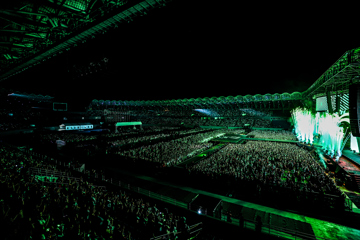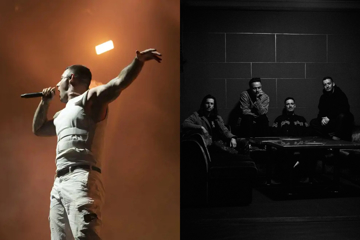'Underworld: Blood Wars' Is Another Time-Killer Out To Barely-Break-Even
"This is a franchise that seems to exist solely as a source manual for Goth cosplay."

UNDERWORLD: BLOOD WARS

Did you know there are now five Underworld films? Do you think there’s anyone out there who’s actually seen all five of them? Your old pal Film Carew, who is literally paid real cash money to watch shitty movies, has only seen four. Which is, to be honest, about three too many. Underworld’s tale of vampires and lycans, battling in modern-day Nowheresville — instalments have been shot in Prague, Budapest, Auckland, and Vancouver — has been lifeless since the drop, but, like the undead, soldiers on unbowed.
This is a franchise that seems to exist solely as a source manual for Goth cosplay. Its wardrobe boasts bountiful black bondage gear: leatherware trenchcoats and bodices, gleaming gloves and platform boots, and, of course, Kate Beckinsale in her signature squeaky latex catsuit. The blackness extends from wardrobe to the film’s palette. The Underworld films are, cumulatively, the darkest in cinema history. Not figuratively, but literally: every frame ran through digital colour-grading that turns its palette all slate, charcoal, and midnight blue; imposing a uniform vision of grim, Gothic, icy, yellow-free underexposure.
Don't miss a beat with our FREE daily newsletter
The fact that the Underworld series exists, and keeps on keepin’ on, shows the persistence of the B-movie blockbuster: movies that are a cut below the topshelf tentpoles in both budget and panache, but deliver a recognisable brand — Kate Beckinsale in her signature squeaky latex catsuit — and all the attendant automatic weaponfire audiences demand. These films aren’t grand works hoping to corral the cultural conversation or convert critics, just time-killers out to barely-break-even at the box-office, and find a long life as video streams.
Underworld: Blood Wars opens with a walk-and-talk that artlessly, hilariously delivers 100% pure exposition. Grave Charles Dance and mischievous Lara Pulver, sounding semi-convincing delivering their eye-rolling lines, effectively Cliff’s-Notes the whole series, delivering a truncated take on the world’s ‘mythology’ — let’s use the word lightly — for anyone who’s seen exactly zero Underworld films. Or, y’know, randomly flicked over on cable.
"It’s a marriage between mock-Shakespearean theatre and All-American gun-worship that, five films in, seems as unconvincing as ever."
The scene itself is one of Underworld’s two kinds: 1) English stage-thesps weightly intoning fluffy fantasy-wonk lines about the war between vampire and lycan, whilst sitting at arcane councils and reading letters removed from wax-sealed envelopes; 2) actors in black leather engaging in semi-automatic shoot-outs, with half of the cast turning, mid-skirmish, into awful-looking CGI wolves. It’s a marriage between mock-Shakespearean theatre and All-American gun-worship that, five films in, seems as unconvincing as ever.
Here, Pulver plays a villainous vamp trussed in ever-varying outfits of abundant cleavage, who’s hungry for power, war and cock. She’s outraged when Beckinsale — hiding out in a, um, hide-out, where an alarm barks ‘Intruder!’ like a randy Dalek when anyone approaches — is brought back from exile. The film’s essential palace intrigue — and the source of a flurry of murderous skulduggery — is the matter of who’ll lead the vampires against the advancing wolfy forces that Tobias Menzies is gathering.
There’s class subtext to this war, of course: the vampires inbred, decadent toffs dwelling in ivory towers; the lycans forging their army in industrial warehouses. Befitting the eugenic fantasia of Bram Stoker’s original Dracula, the phrase “purebloods” is used more, here, than at a dog-breeders; with solemn, Brexit-PR-campaign-worthy sermons warning on the dangers of race-mixing. The lily-whiteness of vamp bloodlines are eventually blown out to full-on Aryan-supremacist/Mormons-in-the-snow fantasy-reel extent, when Beckinsale and Theo James — pulling 2nd-rate-franchise-love-interest double-time alongside the Divergent series — visit a Nordic black-metal castle where everyone has white hair, white skin, and rad back-tatts.
But director Anna Foerster — a debutante with a long history of visual work for… Roland Emmerich! — knows that, to beat back any questions about the creepy subtext and/or general idiocy of the mythology, Blood Wars need only keep on movin’. It’s barely 90 minutes, and stuffed with manifold moments of pure pulp: venomous double-crosses, bloodied killings, gunfire set to pounding drums. Best of all are a host of killings — fighters beheaded and sliced wholly in half, Beckinsale tearing out a lycan spine bare-handed — openly modelled on Mortal Kombat fatalities.
The movie routinely toes the line of outright self-parody, and when James intones “fuck!” in slow-motion at the height of battle, it’s hard to imagine anyone — making the film, or even watching it — taking it seriously. As long as you don’t, either, there’s ironic enjoyment to be had. And, with the promise of more inessential Underworld sequels upon the horizon, more giddy stupidity looms in the multiplex-dumping-ground future.
THE FAMILY FANG

“You have kids, you’re going to damage them,” pronounces Christopher Walken, mid-way through The Family Fang. “That’s what parents do.” These are the wise words of a wise-ass paterfamilias, one whose particular form of fucking-up-his-kids is curious enough to set Jason Bateman’s film apart from the boilerplate family-dysfunction comedies that clutter up Sundance every year. Bateman and Nicole Kidman play the now-grown-up kids who, in their youths, were roped into working in the most-unlikely of family-businesses: situationist performance-art hijinks.
As adults, they’ve endeavoured to distance themselves from their parents (Walken and Maryann Plunkett), but, both floundering in a middle-aged malaise, they’re roped back into the lives of their folks. Who may be old, now, but haven’t given up with the elaborate pranks and conceptual-art sedition. When Walken and Plunkett disappear soon after the kids’ve returned to the nest, the local police suspect foul play. Bateman and Kidman, on the other hand, suspect it’s just another artwork, only this time taken to a new extreme.
With their absent parents now totally absent, they’re left to dig through old closets and their attendant skeletons, to air old grievances and long-held hurts, coming together as siblings, letting go of the past; siblings, families, healing, etc. It’s familiar American-indie-movie stuff that, thanks to black humour, writerly pathos, and winning performances — I love, you love, Christopher Walken — is ultimately effective.
DON’T BLINK: ROBERT FRANK

Don’t Blink belongs to a persistent strain of documentary/rockumentary: New York When It Was Cooler. Here, director Laura Israel chronicles the life and times of photographer-turned-experimental-filmmaker Robert Frank, most famous (or infamous) for directing the legendary ‘lost’ Rolling Stones movie Cocksucker Blues. In her reverence, Israel actually allows her film to get nostalgic for America in the 1950s (!!!), letting the copious cool of beat poets — Frank collaborateur Jack Kerouac and the lingering Allen Ginsberg — distract from the fact that Frank’s definitive work, the 1958 photography book The Americans, beautifully chronicled a brutal landscape of poverty, bigotry, and institutionalised racism.
It’s not all talking-heads nostalgia, though, as Frank himself — still alive, at 92 — is a defiant presence throughout Don’t Blink; both in half-century-old archival footage, and in newly-shot interviews. Back in the day, he was ornery and irascible, now Frank just seems pissed off, a curmudgeonly presence undoing his own story from within. With the subject routinely disrupting the documentary’s making, Israel attempts to approach the film with the kind of abandon and whimsy that Frank made his own films with; Don’t Blink a collage of bent corners, glue smears, notes scribbled in the margins. But, ultimately, for all its mock edginess, it commits the simplest sin of the genre: simply telling viewers that Frank was great, rather than making us feel the same way.
SAND STORM

In a Bedouin village in the remote deserts of Southern Israel, the weather is harsh, the patriarchy harsher. Lamis Ammar, the eldest of four daughters, may have been raised with unexpected freedoms — being taught to drive, studying at university, owning a mobile phone — but when she dares attempt to choose her own future husband, her taciturn father (Hitham Omari) defaults back to bride-peddling tradition. The film opens and closes with ironic wedding celebrations: Omari, on opening, taking his second wife, with the organisation of the festivities presided over by his pissed-off first (Ruba Blal); Ammar, upon close, accepting the fate handed down to her from upon fatherly high.
Sand Storm’s Israeli director, Elite Zexer, is authoring a clear critique of how cultural traditions can impact human rights; but it’s never a lecture from a more permissive culture to a more restrictive one. Instead, she’s interested in two things: the social mechanisms and power structures that are used to oppress the desires of even the most defiant, independent women; and, the savage desert setting, its furious heat, scorching sand, empty vistas. There’s an earnestness, and a dryness, to both the drama and the frames; Sand Storm a film as stern and forbidding as the landscape.







